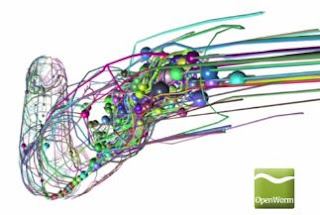“Isn’t it true,” he asks, “ that Darwin preserved a piece of vermicelli in a glass case, until by some extraordinary means it actually began to move with a voluntary motion?”“Are you speaking of the worm,” asks Dr. Frankenstein snidely, hoping to crush the inquisitor with sarcasm, “or the spaghetti?”
- Young Frankenstein
The empirical and the computational are coming together in the OpenWorm Project. how easily and effectively can something as simple as a roundworm be modeled?
OpenWorm aims to build the first comprehensive computational model of the Caenorhabditis elegans (C. elegans), a microscopic roundworm. With only a thousand cells, it solves basic problems such as feeding, mate-finding and predator avoidance. Despite being extremely well studied in biology, this organism still eludes a deep, principled understanding of its biology. [emphasis mine]
A deep, principled understanding of a creature's biology would certainly be nice to have.
From The Complexity Paradox:


Running the clock in reverse? Maybe only some simpler organisms can do this for the same reason that only some simpler organisms can regrow limbs. Which makes me wonder, "Is the transformation of the caterpillar start with a sort of reversal of differentiation? Or must the caterpillar cells die to make room for the differentiating butterfly cells?
From The Complexity Paradox:
Running the clock in reverse? Maybe only some simpler organisms can do this for the same reason that only some simpler organisms can regrow limbs. Which makes me wonder, "Is the transformation of the caterpillar start with a sort of reversal of differentiation? Or must the caterpillar cells die to make room for the differentiating butterfly cells?

No comments:
Post a Comment